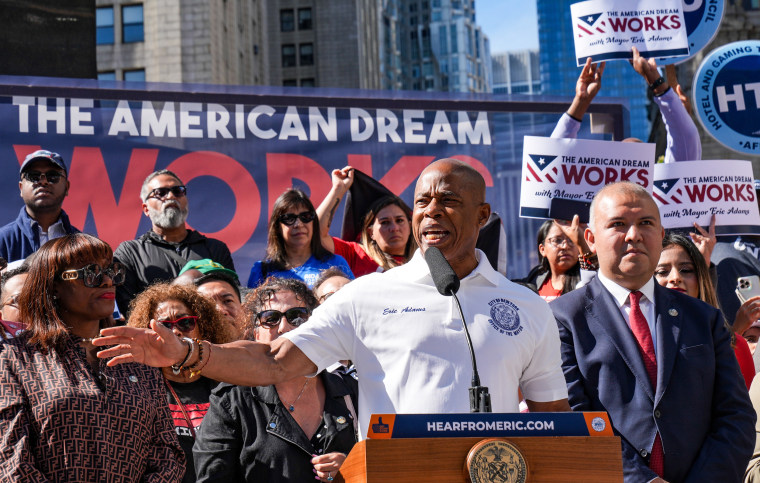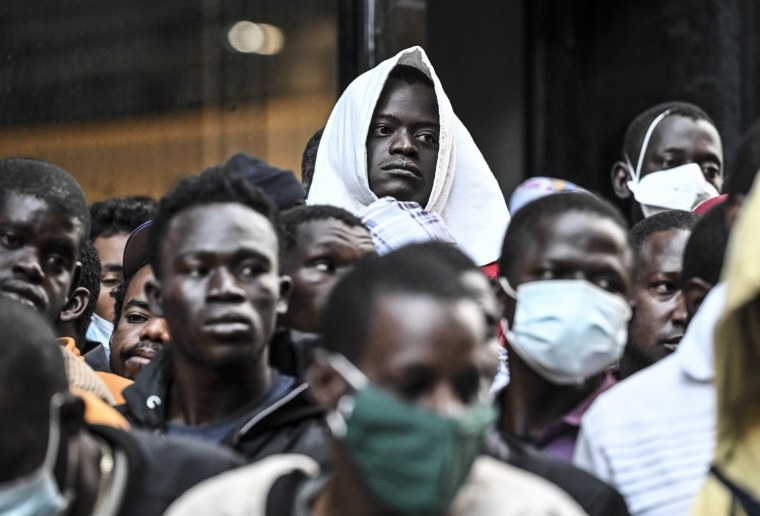There are growing concerns within the Biden administration that New York City is not doing enough to handle its migrant problem, according to several U.S. officials, after a federal team surveyed its migrant operations and found them lacking in key areas.
The Department of Homeland Security sent an “assessment team” in August to study the way the city is handling the more than 100,000 migrants who have come through New York in the past year.
The resulting assessment has not been released publicly, but one senior DHS official familiar with the team’s findings told NBC News the city has “no exit strategy” to see that migrants find their way out of its shelter system.
“It’s not an operationally sound effort,” the official said.
Another federal official said there are concerns that the migrant issue in New York City could overshadow accomplishments made by the Biden administration on immigration and other issues.

New York Mayor Eric Adams agrees the city is having a hard time coping with the thousands of migrants sleeping on its streets and inside its shelters, with the number of monthly arrivals now at 10,000.
“Never in my life have I had a problem that I did not see an ending to. I don’t see an ending to this,” he said Wednesday. “This issue will destroy New York City.”
Responding to criticism from federal officials, a city spokeswoman said the federal government should be doing more.
“As we have said repeatedly, with more than 110,000 asylum-seekers that have come through our care since spring 2022, and hundreds more arriving daily, we cannot continue to work to solve a national crisis that the federal government has refused to take meaningful action on,” said Kayla Mamelak, deputy press secretary in the mayor’s office.
“We have opened more than 200 emergency shelters, have spent more than $2 billion to date, and expect to spend $5 billion this fiscal year alone without substantial aid from our state and federal partners. New York City has far passed its breaking point, and we continue to call on our federal partners to expedite work authorizations, declare a national state of emergency, create a decompression strategy, and lead on this national issue.”
Just this week, the Biden administration and the city made some of their most significant strides toward collaboration.
On Monday, Homeland Security Secretary Alejandro Mayorkas said on MSNBC, “We are working very closely with the city of New York. We sent a team to assess the situation and make significant recommendations, and now we’re executing on those recommendations in close partnership with the city.”
On Tuesday, the White House announced that the National Park Service is finalizing the lease of portions of Floyd Bennett Field in southeast Brooklyn, which has airplane hangars and other buildings, to shelter migrants. The federal government will also move 50 employees to the city over the coming month to teach migrants to access services if they qualify, senior administration officials told reporters.
And both federal and city officials say they are developing a case management system to better assess migrants who might qualify for work authorization or other benefits.
Both city and federal officials have said a large reason why so many recently arrived migrants in New York are homeless is that many do not know their rights and the city does not know who among them might qualify for asylum and work authorization.
According to a second DHS official, the assessment team recommended giving migrants information about how to move through and eventually exit the shelter system, as well as information on how to obtain work authorization and pursue possible asylum claims.
The official said the federal team also recommended that city officials improve the information collected when immigrants arrive at shelters, including a determination of their eligibility to work. According to the official, the team said the city should “focus on case management as a central driver for exit strategy,” meaning a way to move migrants off the streets.
Migrants who have arrived in the United States legally, via the Customs and Border Protection app known as CBP One or through a humanitarian parole program for a limited number of migrants from Cuba, Haiti, Venezuela and Nicaragua, could be immediately eligible for work authorization. But without the city collecting that information, it’s difficult to know who might be able to work and become less dependent on the city for shelter, the second DHS official said.
The city has had its own complaints about the federal efforts. Adams has called on DHS to grant temporary protected status for many of the migrants in New York, a move that would make them eligible to apply for work permits. But DHS officials say it would not be so easy.
New York has a “right to shelter” policy, which requires the city to provide shelter to anyone who arrives there, regardless of immigration status. Adams has blamed the policy for attracting migrants, and has also blamed Texas Gov. Greg Abbott for busing migrants from the southern border to New York and other cities such as Washington, D.C., Chicago and Los Angeles.
Unlike many populations of migrants who previously came through New York, recent arrivals from countries such as Venezuela, Haiti and Nicaragua often don’t have family who can offer them a place to stay and some financial support. Cities like New York have become a final stop for migrants with no other place to go.

